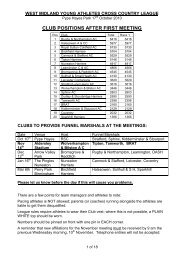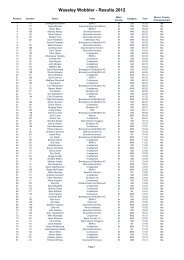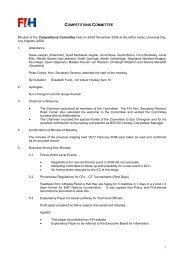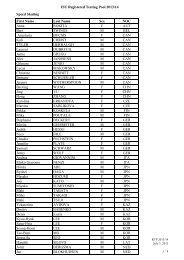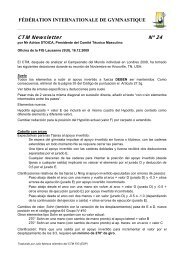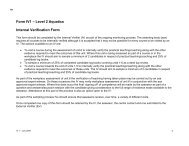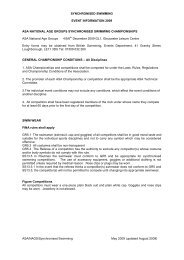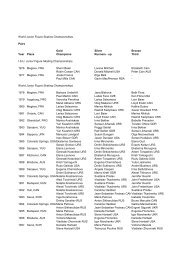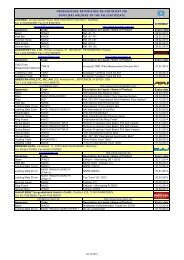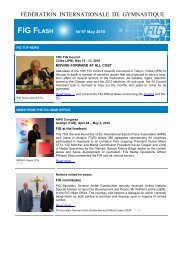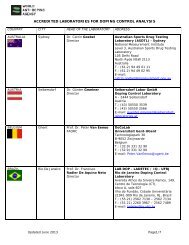Unit 2 – Principles of Teaching/<strong>Coaching</strong> – (Core to all <strong>Level</strong> 2 qualifications)Overview of Unit 2This is a mandatory unit.This is a core unit and links across all strands of <strong>UKCC</strong> (Aquatic Teaching, <strong>Diving</strong>, Swimming<strong>Coaching</strong>, Synchronised Swimming and Water Polo). This unit explores the issues relating toPlanning of Teaching/<strong>Coaching</strong> relating to a <strong>Level</strong> 2 Teacher/Coach.AssessmentEach unit is split into elements. All elements within Unit 2 will be assessed through ongoingcoursework tasks i.e., via practical observation, oral questioning and/or written evidence produced aspart of the learning programme.Element 1 - Roles and ResponsibilitiesTo achieve this element the candidate must be able to:U2.1.1 Explain the roles and responsibilities of the teacher/coachU2.1.2 Identify minimum standards of behaviour <strong>for</strong> individual personal practiceSyllabus:• Teacher/Coach Role: plan, prepare, deliver and evaluate a series of sessions within a prepreparedlong term plan in order to improve a participants per<strong>for</strong>mance• Responsibilities: e.g. - motivation and enjoyment, promoting good practice, duty of care,health & safety of self and others, supporting others, supervising <strong>Level</strong> 1 teachers/coaches• Self Presentation: e.g. – dress, language, attitude of self, attitude toward othersElement 2 – Communication and Communication StylesTo achieve this element the candidate must be able to:U2.2.1 Identify methods of communication that will create and maintain positive and equitableworking relationships with participants and othersU2.2.2 Identify communication styles that will reflect the learning styles of participants and othersU2.2.3 Identify common administrative procedures used in teaching/coachingSyllabus:• Methods of Communication: verbal e.g. effective questioning (open and closed); effectivefeedback; voice protection/projection, effective listening skills; Non Verbal e.g. body language,written, demonstration• Learning Styles: visual, auditory, kinaestheticAdministration• Common Administration Procedures: e.g. - report writing, presentations, recording data, filing, useof in<strong>for</strong>mation technologyPage 6
Element 3 – Planning and EvaluationTo achieve this element the candidates must be able to:U2.3.1 Explain the planning processU2.3.2 Identify in<strong>for</strong>mation required to plan a sessionU2.3.3 Explain the different needs of a range of participantsU2.3.4 Identify appropriate methods to collect review and analyse participants’ needsU2.3.5 Identify guidelines <strong>for</strong> dealing with confidential in<strong>for</strong>mationU2.3.6 Identify alternative activities as appropriate to meet changing needs of participants and theteaching/coaching environmentU2.3.7 Explain the purpose and value of evaluationU2.3.8 Identify evaluation methods that can be used to monitor development and learning <strong>for</strong>participants, self and othersU2.3.9 Identify the opportunities <strong>for</strong> evaluation of self and othersSyllabus:Planning• The Planning Process: e.g. schemes of work, planning <strong>for</strong> a week/term/year, session plans• In<strong>for</strong>mation Required to Plan: e.g. session outcomes, participants, resources, contentboundaries, health and safety, timings, duration, technical content, linked activities• Range of Participants: e.g. beginners, expert, children, elderly, needs• Needs of Participants: e.g. appropriate activities, intensity, environment, additional support• Methods to Collect In<strong>for</strong>mation: questioning, written <strong>for</strong>ms, discussion, in<strong>for</strong>mation fromothers, feedback• Dealing with In<strong>for</strong>mation: data protection, disclosure of in<strong>for</strong>mation• Planning <strong>for</strong> Self and Others: flexibility; adaptation; improvisation; range of participants;different individual’s needsEvaluation• Purpose and Value of Evaluation: e.g. feedback on per<strong>for</strong>mance (participant andteacher/coach), future development, future planning• Methods of Evaluation: e.g. discussion with participants, peer review, self reflection,technologies (video)• Opportunities <strong>for</strong> Evaluation: e.g. previous session, agreed observations, feedbackopportunities, self review, participants per<strong>for</strong>manceElement 4 – Teacher’s/Coach’s Tool BoxTo achieve this element the candidate must be able to:U2.4.1 Identify the stages of Long Term Athlete Development (LTAD)U2.4.2 Describe the impact that LTAD has on the teaching/coaching processU2.4.3 Explain the need to refer participant(s) who cannot be supported within the currentteaching/coaching environmentU2.4.4 Identify and explain the stages within the teaching/coaching cycleU2.4.5 Identify preferred teaching/coaching philosophy and teaching/coaching style <strong>for</strong> selfSyllabus:Effective Teaching/<strong>Coaching</strong>• The Teaching/<strong>Coaching</strong> Cycle: prepare, plan, deliver, monitor, evaluate• Teaching/<strong>Coaching</strong> Styles: autocratic e.g.- telling and selling, democratic e.g.- sharing andallowing, laissez-faire, understanding personal teaching/coaching philosophyLong Term Athlete Development• LTAD: FUNdamentals, skill development, training to train; competitive development,per<strong>for</strong>mance• Impact of LTAD on the teaching/coaching process: teaching/coaching process, participantreferralPage 7



